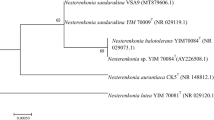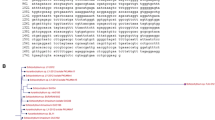Abstract
Carotenoids are a class of naturally occurring pigment, carrying out important biological functions in photosynthesis and involved in environmental responses including nutrition in organisms. Saproxanthin and myxol, which have monocyclic carotenoids with a γ-carotene skeleton, have been reported to show a stronger antioxidant activity than those with β-carotene and zeaxanthin. In this research, a yellow-orange bacterium of strain 11shimoA1 (JCM19538) was isolated from a seaweed collected at Nabeta Bay (Shizuoka, Japan). The 16S rRNA gene sequence of strain 11shimoA1 revealed more than 99.99 % similarity with those of Jejuia pallidilutea strains in the family Flavobacteriaceae. Strain 11shimoA1 synthesized two types of carotenoids. One of them was (3R, 3’R)-zeaxanthin with dicyclic structure and another was identified as (3R, 2’S)-2′-isopentenylsaproxanthin, a novel monocyclic carotenoid with pentenyl residue at C-2′ position of saproxanthin, using FAB-MS, 1H NMR, and CD analyses. Culturing strain 11shimoA1 in an alkaline medium at pH 9.2 resulted in a markedly increased in production of 2′-isopentenylsaproxanthin per dry cell weight, but a decreased in zeaxanthin production as compared to their respective production levels in medium with pH 7.0. These carotenoids are likely to play some roles in the adaptation of the bacterium to the environmental conditions.




Similar content being viewed by others
References
Aasen AJ, Liaaen-Jensen S (1966) The carotenoids of flexibacteria: II. A new xanthophyll from Saprospira grandis. Acta Chem Scand 20:811–881
Beatty S, Murray IJ, Henson DB, Carden D, Koh H, Boulton ME (2001) Macular pigment and risk for age-related macular degeneration in subjects from a Northern European Population. Invest Ophthalmol Vis Sci 42:439–446
Bhosale P, Bernstein PS (2004) β-Carotene production by Flavobacterium multivorum in the presence of inorganic salts and urea. J Ind Microbiol Biotechnol 31:565–571
Britton G (1990) Carotenoid biosynthesis—an overview. In: Krinsky NI, Mathews-Roth MM, Taylor RF (eds) Carotenoids: Chemistry and biology. Plenum Press, New York, pp 167–184
Britton G, Liaaen-Jensen S, Pfander H (1995) Carotenoids volume 1a: Isolation and analysis. Birkhäuser, Basel, Switzerland
Britton G, Liaaen-Jensen S, Pfander H (2004) Carotenoids Handbook. Birkhauser Verlag, Basel, Switzerland
Buchecker R, Noack K (1995) Circular dichroism. In: Britton G, Liaaen-Jensen S, Pfander H (eds) Carotenoids, vol 1B. Birkhäuser, Basel, pp 63–116
D’Souza SE, Altekar W, D’Souza SF (1997) Adaptive response of Haloferax mediterranei to low concentrations of NaCl (<20 %) in the growth medium. Arch Microbiol 168:68–71
Dasek J, Sheperd D, Traelnes RK (1973) Proced de production de zeaxanthin. Belgium Patent 790289
Englert G (1995) NMR spectroscopy. In: Britton G, Liaaen-Jensen S, Pfander H (eds) Carotenoids, vol 1B. Birkhäuser, Basel, pp 147–160
Fernández-Gómez B, Richter M, Schüler M, Pinhassi J, Acinas SG, González JM, Pedrós-Alió C (2013) Ecology of marine Bacteroidetes: a comparative genomics approach. ISME J 7:1026–1037
Folch J, Lees M, Sloane-Stanley GH (1957) A simple method for the isolation and purification of total lipids from animal tissues. J Biol Chem 226:497–509
Fong NJ, Burgess ML, Barrow KD, Glenn DR (2001) Carotenoid accumulation in the psychrotrophic bacterium Arthrobacter agilis in response to thermal and salt stress. Appl Microbiol Biotechnol 56:750–756
Goodwin TW (1980) The biochemistry of carotenoids, 1. Plants, 2nd edn. Chapman and Hall, London
Gorham HC, McGowan SJ, Robson PR, Hodgson DA (1996) Light-induced carotenogenesis in Myxococcus Xanthus: light-dependent membrane sequestration of ECF sigma factor CarQ by anti-sigma factor CarR. Mol Microbiol 19:171–186
Jackson H, Braun CL, Ernst H (2008) The chemistry of novel xanthophyll carotenoids. Am J Cardiol 101:50D–57D
Jagannadham MV, Rao VJ, Shivaji S (1991) The major carotenoid pigment of a psychrotrophic Micrococcus roseus strain: Purification, structure, and interaction with synthetic membranes. J Bacteriol 173:7911–7917
Lee DH, Kahng HY, Lee YS, Jung JS, Kim JM, Chung BS, Park SK, Jeon CO (2009) Jejuia pallidilutea gen. nov., sp. nov., a new member of the family Flavobacteriaceae isolated from seawater. Int J Syst Evol Microbiol 59:2148–2152
McDermott JCB, Brown DJ, Britton G, Goodwin TW (1974) Alternative pathway of zeaxanthin biosynthesis in a Flavobacterium species. Biochem J 144:231–243
Milborrow BV (2001) The pathway of biosynthesis of abscisic acid in vascular plants: a review of the present state of knowledge of ABA biosynthesis. J Exp Bot 52:1145–1164
Misawa N (2011) Carotenoid β-ring hydroxylase and ketolase from marine bacteria-promiscuous enzymes for synthesizing functional xanthophylls. Mar Drugs 9:757–771
Miyashita K, Nishikawa S, Beppu F, Tsukui T, Abe M, Hosokawa M (2011) The allenic carotenoid fucoxanthin, a novel marine nutraceutical from brown seaweeds. J Sci Food Agric 91:1166–1174
Naguib YM (2000) Antioxidant activities of astaxanthin and related carotenoids. J Agric Food Chem 48:1150–1154
Pashkow FJ, Watumull DG, Campbell CL (2008) Astaxanthin: a novel potential treatment for oxidative stress and inflammation in cardiovascular disease. Am J Cardiol 101:58D–68D
Sawabe T, Sugimura I, Ohtsuka M, Nakano K, Tajima K, Ezura Y, Christen R (1998) Vibrio halioticoli sp. nov., a nonmotile alginolytic marine bacterium isolated from the gut of the abalone Haliotis discus hannai. Int J Syst Bacteriol 48:573–580
Sheperd D, Dasek J (1974) Proced de preparation de zeaxanthin. Belgium Patent 816876
Sheperd D, Dasek J, Carels M (1974) Proced de production de zeaxanthin. Belgium Patent 816767
Shindo K, Kikuta K, Suzuki A, Katsuta A, Kasai H, Yasumoto-Hirose M, Matsuo Y, Misawa N, Takaichi S (2007) Rare carotenoids, (3R)-saproxanthin and (3R,2’S)-myxol, isolated from novel marine bacteria (Flavobacteriaceae) and their antioxidative activities. Appl Microbiol Biotechnol 74:1350–1357
Shoeher A, Wis O (1972) Proced pour la preparation de zeaxanthin. Belgium Patent 770744
Sommerburg OG, Siems WG, Hurst JS, Lewis JW, Kliger DS, van Kuijk FJ (1999) Lutein and zeaxanthin are associated with photoreceptors in the human retina. Curr Eye Res 19:491–495
Storz G, Hengge-Aronis R (2000) Bacterial stress responses. American Society for Microbiology, Washington, DC
Takaichi S, Mochimaru M (2007) Carotenoids and carotenogenesis in cyanobacteria: Unique ketocarotenoids and carotenoid glycosides. Cell Mol Life Sci 64:2607–2619
Takaichi S, Wang ZY, Umetsu M, Nozawa T, Shimada K, Madigan MT (1997) New carotenoids from the thermophilic green sulfur bacterium Chlorobium tepidum: 1′,2’-dihydro-gamma-carotene, 1′,2’-dihydrochlorobactene, and OH-chlorobactene glucoside ester, and the carotenoid composition of different strains. Arch Microbiol 168:270–276
Takaichi S, Maoka T, Masamoto K (2001) Myxoxanthophyll in Synechocystis sp. PCC 6803 is myxol 2’-dimethylfucoside, (3R, 2’S)-myxol 2’-(2,4-di-O-methyl-a-L-fucoside), not rhamnoside. Plant Cell Physiol 42:756–762
Takaichi S, Mochimaru M, Maoka T, Katoh H (2005) Myxol and 4-ketomyxol 2’-fucosides, not rhamnosides, from A nabaena sp. PCC 7120 and Nostoc punctiforme PCC 73102, and proposal for the biosynthetic pathway of carotenoids. Plant Cell Physiol 46:497–504
Tamura K, Peterson D, Peterson N, Stecher G, Nei M, Kumar S (2011) MEGA5: Molecular evolutionary genetics analysis using maximum likelihood, evolutionary distance, and maximum parsimony methods. Mol Biol Evol 28:2731–2739
Tanaka T, Shnimizu M, Moriwaki H (2012) Cancer chemoprevention by carotenoids. Molecules 17:3202–3242
Teramoto M, Rählert N, Misawa N, Sandmann G (2004) 1-Hydroxy monocyclic carotenoid 3,4-dehydrogenase from a marine bacterium that produces myxol. FEBS Lett 570:184–188
Thompson JD, Gibson TJ, Plewniak F, Jeanmougin F, Higgins DG (1997) The ClustalX windows interface: Flexible strategies for multiple sequence alignment aided by quality analysis tools. Nucleic Acids Res 24:4876–4882
Thomson LR, Toyoda Y, Langner A, Delori FC, Garmett KM, Craft N, Nichols CR, Cheng KM, Dorey CK (2002) Elevated retinal zeaxanthin and prevention of light-induced photoreceptor cell death in quail. Invest Ophthalmol Vis Sci 43:3538–3549
Wiegert T, Homuth G, Versteeg S, Schumann W (2001) Alkaline shock induces the Bacillus subtillis sigma (W) regulon. Mol Microbiol 41:59–71
Wisniewska A, Subczynski WK (1998) Effects of polar carotenoids on the shape of the hydrophobic barrier of phospholipid bilayers. Biochim Biophys Acta 1368:235–246
Yokoyama A, Miki W (1995) Isolation of myxol from a marine bacterium Flvobacterium sp. associated with a marine sponge. Fish Sci 61:684–686
Yokoyama A, Sandmann G, Hoshino T, Adachi K, Sakai M, Shizuri Y (1995) Thermozeaxanthins, new carotenoid-glycoside-esters from thermophilic eubacterium Thermus thermophilus. Tetrahedron Lett 36:4901–4904
Acknowledgements
This work was supported by Grants-in Aid for Scientific Research from MEXT (Ministry of Education, Culture, Sports, Science, and Technology of Japan) (No. 23380120 to M.H.) and Strategic Japanese-Brazilian Cooperative Program (JST-CNPq).
Author information
Authors and Affiliations
Corresponding author
Electronic supplementary material
Below is the link to the electronic supplementary material.
ESM 1
(PDF 67 kb)
Rights and permissions
About this article
Cite this article
Takatani, N., Nishida, K., Sawabe, T. et al. Identification of a novel carotenoid, 2′-isopentenylsaproxanthin, by Jejuia pallidilutea strain 11shimoA1 and its increased production under alkaline condition. Appl Microbiol Biotechnol 98, 6633–6640 (2014). https://doi.org/10.1007/s00253-014-5702-y
Received:
Revised:
Accepted:
Published:
Issue Date:
DOI: https://doi.org/10.1007/s00253-014-5702-y




